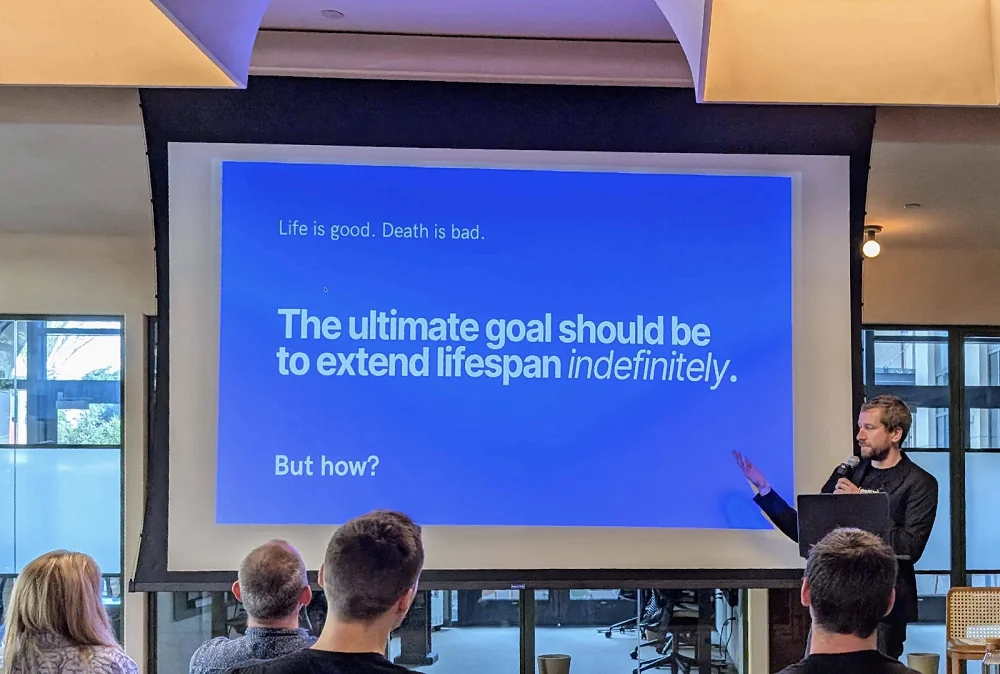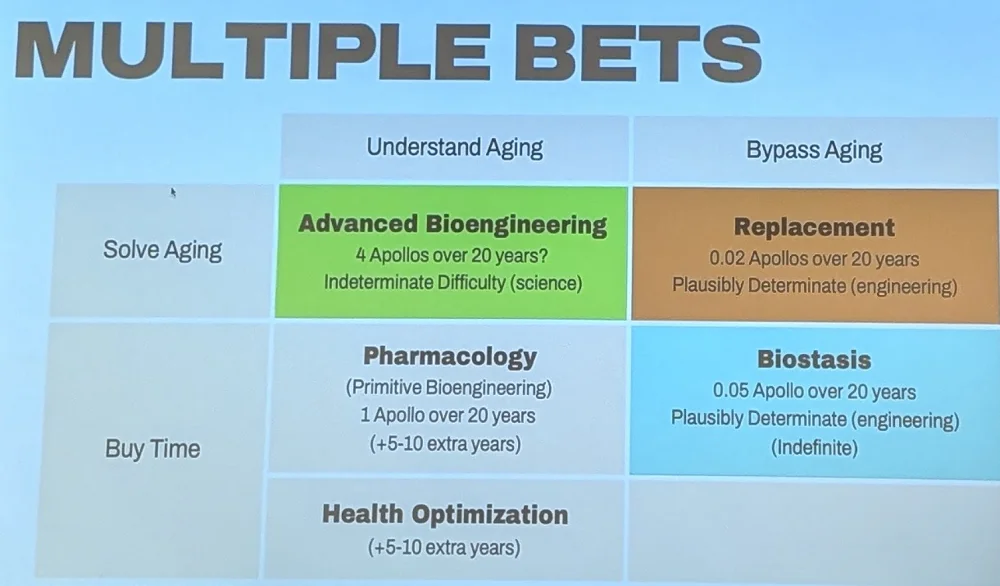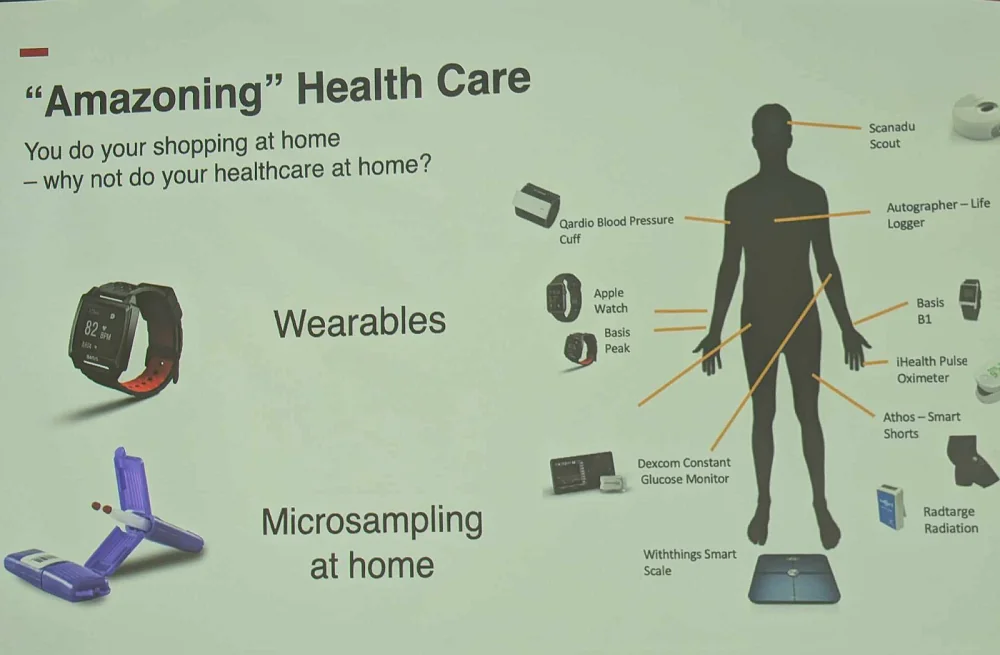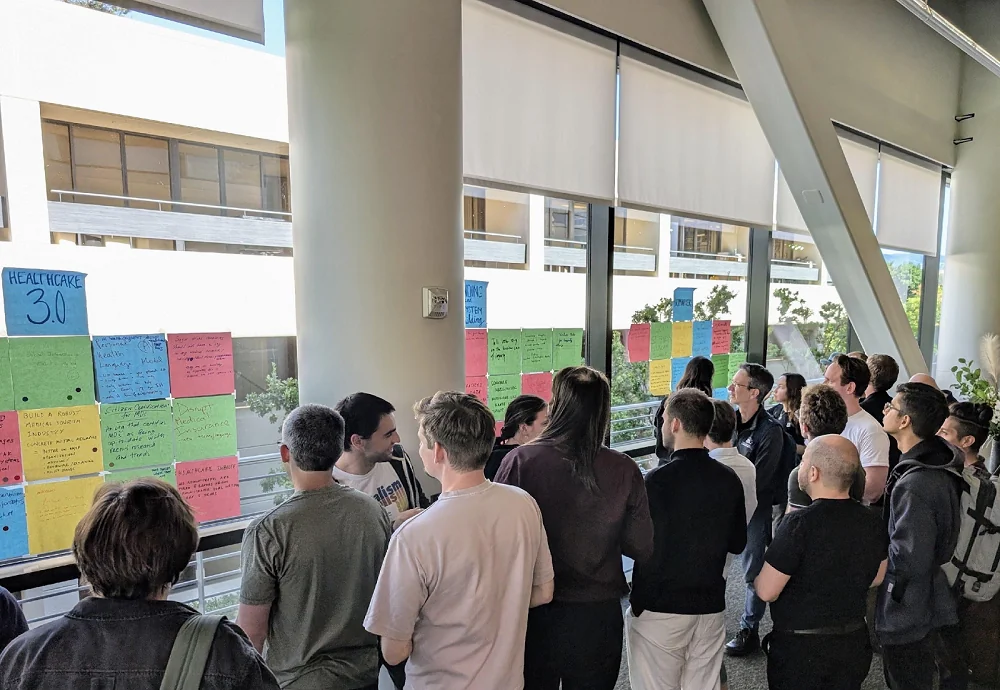When Foresight Institute and Longevity Biotech Fellowship joined forces, a one-of-a-kind longevity event emerged.
Something different
There’s a time-tested recipe for a scientific conference: people come on stage one by one, give talks, and receive tepid-to-warm applause, and then there’s a rush to the hall, where everyone grabs a snack and engages in the Brownian motion known as networking. From time to time, four to five people gather on stage and have a rather contorted conversation: that’s a panel.
Don’t get me wrong: I love conferences and recognize their value. You get to hear about new research, including unpublished data, forge new connections, and nurture old ones, and there’s always a chance for a karaoke night. Jokes aside, conferences are important.
Yet, there’s also this nagging feeling of more of the same that many conference-goers can relate to. Conferences can feel like a testament to both the longevity field’s growing prowess and to its slow advance.
One organization worried about the rate of progress is the Longevity Biotech Fellowship (I recently interviewed its founders, Mark Hamalainen and Nathan Cheng). LBF has been pushing boundaries, advocating for the boldest possible approach to life extension as well as for major changes in regulation and public perception of longevity. Accelerating progress in the longevity field is LBF’s overarching goal, and the organization is constantly looking for new forms of collaboration and ideation.
Then, there’s Foresight Institute. Unlike LBF, which has been around for only a couple of years, Foresight Institute was established in 1986 to accelerate advances in nanotechnology. With time, it expanded into other areas, including longevity.
Foresight Institute has been perfecting the workshop formula for years. According to Foresight CEO Allison Duettmann, it’s been quite successful, with numerous ideas, which were originally thrown around at workshops, becoming projects and getting funded. For instance, a molecular machines project eventually got millions in funding from the Department of Defense and turned into a company.
Longevity-oriented workshops started in 2022. This year, the two organizations joined forces to create the LBF/Foresight Longevity Workshop 2024.
How did the collaboration with LBF come about? “I have been a big fan of LBF since its foundation and know the founders well,” says Allison. “LBF’s Roadmap and Foresight’s Longevity Tech Tree highlight the same topics as high-impact, so we thought we would collaborate on a workshop to bring our communities together and accelerate progress.”
Framing the problem
The two-day event was held at Stanford University, the source of some of the finest research in longevity. It was modest both in attendance and duration, but it just didn’t feel that way.
From the get-go, something was different. The co-working place near Stanford was buzzing with good energy emanating from a bunch of smiling, over-caffeinated people. It took some time for the organizers to calm everyone down and start the proceedings.
After opening remarks by Allison and Sonia Arrison, head of 100 Plus Capital, it was the turn of Mark and Nathan to present this year’s focus areas: Acceleration (tools to increase the rate of progress in biotech), Replacement (bypassing aging complexity by swapping old for young tissue), Bioengineering (measuring, modeling and gene delivery to solve aging ), Biostasis (saving lives with reversible stasis for organs and full humans), and Healthcare 3.0 (affordable health and lifespan extension for all of humanity).

Mark Hamalainen states the obvious in his opening keynote talk.
In his keynote talk, Mark explained LBF’s Roadmap to Solving Aging. Among other things, he presented a simple diagram of “multiple bets”, which means that we should attack aging from every possible angle.

The pharmacological approach is heavily favored today, but it has its limitations. While it requires certain understanding of aging, it can probably add just 5-10 years to human lifespan (“buying time”). Biostasis (which mostly means cryopreservation) is another way to buy time – an indefinite amount of it, in fact, and that’s without understanding aging.
Organ and tissue replacement is another way to “hack” or bypass aging without really understanding how it works. It’s probably the most cost-effective route right now (Mark suggested measuring costs in “Apollo programs”). Finally, advanced bioengineering has few limitations and can potentially solve aging completely, but it requires a much deeper understanding of biology than we currently have and immense amounts of money.
Keep it short!
After the keynote, it was time for the themed sessions. Each one began with a string of flash presentations of just seven minutes each. This would be considered an insult at a regular conference, but here, the speakers seemed to enjoy the rules of the game, rushing to make their point and a joke or two.
In the spirit of the workshop, let me make a very rushed presentation of some of the speakers. One of the first on day 1, Michael Antonov, co-founder of Oculus, talked about his company, DeepOrigin, which builds AI models of biology and tools for lab automation.
Jean Hebert is one of the very few people who work on radically tackling brain aging using progressive brain tissue replacement. Combined with innate neocortical plasticity, he said, this can reverse brain aging without discontinuity of self.
Omri Amirav of Renewal Bio reported on his company’s unique success in creating embryo-like structures (“embryoids”) from human stem cells. Such structures can be valuable research models, without ethical problems attached, and open opportunities for creating various anti-aging treatments.
Christopher Bradley represented Matter Bio, one of the most interesting companies in the longevity space. Matter is going after somatic mutations, a hallmark of aging that, until recently, was considered untargetable. Now, with the novel methods of identifying mutations and repairing DNA, this problem is starting to budge, and it’s a huge deal.
Emil Kendziorra heads TomorrowBio, a relatively new player in the field of human cryopreservation. Founded in Europe, TomorrowBio is already expanding to the US with state-of-the-art cryopreservation technology. This “insurance policy” might be a smart bet, given all the uncertainties of human life and the less-than-satisfactory current rate of progress in the longevity field.
Day 2 started with a keynote talk by a local: Michael Snyder, professor at Stanford University. The talk revolved around using multi-omic analysis to understand aging. Michael’s central premise was that everyone ages differently, as multi-omics show convincingly (many researchers say that this suggests that aging is not a program).
Michael then talked about “Amazoning healthcare” using the ever-expanding universe of wearables, such as smart watches and constant glucose monitors. Apparently, wearables can already be used for diagnostic tasks, such as early detection of Lyme disease and COVID infection just by measuring simple parameters like heart rate.

Continuous glucose monitoring (CGM) highlights the amazing heterogeneity in response to various foods. Some people see the highest glucose spikes from bread, while others don’t. For some, it’s potatoes, and for others, it’s grapes. Michael implored the audience to ditch sweetened breakfast cereals as the most common denominator.
Michael’s talk was a perfect segue to Day 2’s topic: Healthcare 3.0. The overarching theme was that healthcare will have to become much more personalized, providing bespoke solutions to the highly heterogeneous aging trajectories that people develop.
One prerequisite for it, as well as for anti-aging research in general, is having reliable biomarkers of aging. A whole session was devoted to them. Vadim Gladyshev of Harvard provided a great overview of where the field is standing on biomarkers, and Nikola Markov of Buck Institute gave a talk on the need for a “consumer-accessible measuring platform for biomarkers of health.”
Several talks were dedicated to building a longevity ecosystem. Nathan Cheng wore a different hat and told the audience about Vitalism, the pro-longevity movement he co-founded with Adam Gries.
NIklas Anzinger talked about Vitalia, a “longevity city” which exists since the last year in Prospera, a special economic zone located on Roatan, a Carribean island that belongs to Honduras. Vitalia, co-founded by Niklas, began as a pop-up city, but now, it sports a continuous presence of several dozen longevity enthusiasts and offers enticing conditions to longevity biotech companies.
Stefanie Dainow, Lifespan.io CEO, took the stage to tell the crowd about the upcoming merger of Lifespan.io with another important non-profit in the longevity field, SENS Research Foundation. The merger is creating an organization with an even wider reach and range of activities, which now include state-of-the-art research projects run out of SENS’ Bay Area headquarters (where you can rent quality lab space).
Stephanie also discussed ways to talk about longevity to the general public and decision makers. “Marketing longevity” is not simple considering that most people view meaningful life extension as science fiction. People involved in the field know that achieving this is going to be hard but also that it is possible, maybe in the not-so-distant future. This understanding drives them forward, and they must be able to communicate it to the outside world – something that Lifespan.io has excelled at for years.
Big ideas on big Post-it notes
Seven minutes per talk might not be enough to seriously educate the audience on a given topic, but that wasn’t the point. The talks, fascinating and informative as they were, were there first and foremost to set the mood for working in breakout groups.
After each session, the attendees were divided into groups by means of a plausible replica of the Hogwarts sorting hat. Over the course of 40 minutes, each group had to come up with three ideas on the given topic, concise enough to be put on a giant Post-it note.
Sometimes, it felt like a fun game, an exercise in creativity, or an unwanted chore, depending on the group’s mood and dynamics. There were also a lot of profound moments when we excitedly thought we were on to something, but it was for the audience to decide. After each session, the Post-it notes were hung on a wall for everyone to see and judge, and at the end of each day, people were given a bunch of tiny stickers to vote on the projects. The best project of the day was awarded 1,500 dollars.
Scribbling on giant Post-it notes might seem unserious, but I firmly believe that even non-realized ideas make an imprint by engendering new ones. Also, email me if you want to fund any of my workshop ideas, haphazardly sketched at the very last moment, such as replacing atherosclerotic arteries with lab-grown ones!

Workshop attendees judge each other’s half-baked ideas.
All this buzz created a lot of healthy appetite which we quenched with the food inspired by Bryan Johnson’s Blueprint. Bryan was there in person, apparently content with the dishes’ quality. However, if you want to know what a real Don’t Die Dinner at Bryan’s house looks like, read this.
I can’t speak for all the attendees, but for me, the workshop created a lasting feeling of optimism and camaraderie. Importantly, it also reflected the fact that many ideas that, just recently, were considered outlandish and fringe are now discussed with much more seriousness and respect alongside more conventional ones.
Nathan Cheng agrees: “It was refreshing to be able to freely discuss ideas beyond the mainstream longevity Overton window, everything from whole-body replacement to biostasis and radical genetic engineering.”
“The unique power of the LBF + Foresight workshop”, he added, “was bringing together highly intelligent and rational scientists, entrepreneurs, engineers, and investors all aligned on the explicit goal of solving aging completely — not merely studying or partially ameliorating it.“







